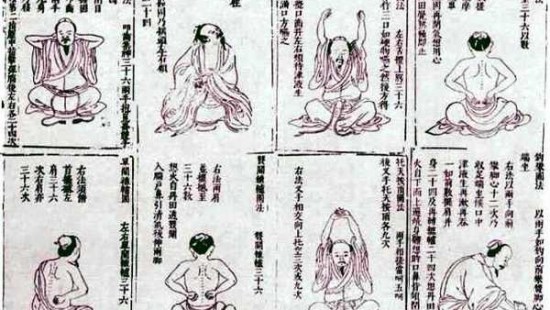History
This approach was refined over 60 years of study and teaching by Dr Li Shao Bo, intending to give a method for improving health. The practices can also be seen as a simple way to grasp the foundations of NeiDan or Daoist internal alchemy.
Posture
The practice can be done in all four primary postures, and over time the practitioner should work to make this their natural state. The four postures are:
- Standing
- Sitting
- Walking
- Lying
The sitting posture is the one that we will focus on; more detailed instruction on the other postures will be outlined in a later article.
Sitting in a chair
- The feet should be resting in the floor with the knees slightly under the high of the hips.
- Both thighs should be parallel
- The palms resting on the knees or the lower thighs.
- The spine should be upright but maintain its natural curve (do not force it to be perfectly straight)
- The head is suspended from the rear crown, pulling the chin in slightly.
- The tongue should be placed on the roof of the mouth, pointing towards the nose with the jaw lightly shut.
- The eyes should be closed or slightly shut.
Sitting on a floor
This posture is similar to sitting on a chair with a few exceptions
- The legs should be folded comfortably with both knees touching the ground; there is no need for lotus or other positions.
- The hips should be resting above the height of the knees through the use of a Cushion.
- The palms resting on the knees or the lower thighs.
- The spine should be upright but maintain its natural curve (do not force it to be perfectly straight)
- The head is suspended from the rear crown, pulling the chin in slightly.
- The tongue should be placed on the roof of the mouth, pointing towards the nose with the jaw lightly shut.
- The eyes should be closed or slightly shut.
Breathing
Several qualities should be cultivated with the breath and its connection to the mind.
- The inhalations should be soft and long with minimal intention; they should also be inaudible.
- Exhalations should be caused through a state of release, or by just letting go and fully allowed to end with as little as possible mental control.
- The mind should follow and focus on the destination of the breath; they are brought together by the weight of the mind encouraging the breath to sink rather than by any force.
- On the exhalation, the mind should continue to sync towards the destination and inwards and not follow the breath out; this should be again like a weight sinking rather than being pushed.
It may take a long time to connect the body, breath, and mind and to allow the stages of the breath and the continual inward sinking to happen with little or no intention. The mind’s involvement is through awareness, which is often opposite to all the other activities in our life.
Practice note
It is easy for the mind to wonder and to lose focus in the beginning; I found it helpful to have an occasional alarm (quiet beep) to use as a reminder to bring my focus back to the practice.
The other practice that can be used at the beginning is to count the inhalations and exhalations to maintain a level of focus, and both these practices should be outgrown.
Stage 1 – Beginning to sink the breath – reaching the Yellow Court (top of the abdomen)
This practice stage is the first phase in learning to sink the breath (Qi); it can take a long time to achieve. I cannot stress how important it is that all the stages are achieved deeply, and it is not rushed.
The destination point for the breath at this stage is the solar plexus or just below (the yellow court). The breath and mind should connect at the nose during the inhale, and the pressure from the breath should be followed down until it rests in the yellow court. The exhalation, the weight of the mind, should continue to sync to this point.
The breath reaching this point is not the only criteria of success at this stage; the others are:
- The breath is smooth and inaudible
- The mind syncs with the breath and into the yellow court on the exhalation.
- The volume and duration of the breath increase without any forced mental control.
- The upper body becomes more relaxed, and the movement of breath can be fully experienced.
Stage 2 – The mind in the Lower Dantian (on exhalation)
When the criteria of the first step have been achieved, the mind and the breath must be gently encouraged to sync further to the lower Dantian (a point above the perineum and three fingers below the navel). On the exhalation, the mind should continue to sync towards the Lower Dantian.
It may take some time for the inhalation to touch the Dantian, but you must follow with the mind and do not attempt to force it. A little more intention can be used when the mind is sink during the exhalation towards the lower Dantian.
Over time the inhalation will reach the lower Dantian, and a pressure (expansion) will be felt in the lower abdomen. The exhalation will cause a soft compression towards the Dantian, increasing a sensation of pressure or heat.
The correct time must be taken to achieve this stage, and the same criteria as stage one are further deepened.
Stage 3 – Breath and Mind in the Dantian at all times – also referred to as the filling of the Dantian.
This is a natural progression of Stage 2. It’s when the Mind is resting and sinking deeper into the lower Dantian. The inhalation syncs to the centre of the lower Dantian and creates the sensation of a soft opening or increase in size. The exhalation will naturally compress towards the centre.
Over time there will be feelings of heat, movement, and itching in the centre, and eventually, this sensation will become consistent. When this is achieved, there may also be feelings of movement and the heat overflowing, at this point, it’s time to move to stage 4.
It is essential that even when this stage has success, it is still practised as part of the daily training.
Stage 4 – Opening the Du and Ren
It is essential at this stage that the tongue is touching the roof of the mouth.
This stage may begin to happen on its own, this is the best solution, but it can be encouraged with the use of a soft intention. Let the mind bring the heat (Qi) from the Dantian towards the Hui Yin and the tailbone, and this will cause the Qi to slowly fill and open the Du meridian running up the centre of the back and spine. When it reaches the top it will run down the Ren meridian which runs down the front of the body.
It may take some time for this to happen, and it is essential that the mind as much as possible, is only using awareness, and you do not try to Fouracre the opening or the flow.
At this stage, when the practice is finished, you must spend some time focusing the mind and its awareness into the lower dantian and feel the body has settled before ending the practice.
There are methods for supporting the opening of the small heavenly cycle, but I will discuss them in other articles; the key point of this practice is that it happens as part of the natural stages of development.
Stage 5 – Large Circulation
This is a natural continuation of stage 4 and Qi or heat moving through all the eight extraordinary meridians, this will happen naturally when Qi is abundant and the first circulation is fully open.
During this stage, there are many experiences that the practitioner could experience and the process of it opening may take several years if not longer.
Summary
Dr Li Shao Bo outlined the early stages of Neidan in these five steps. There are methods to support or force the different stages using focused intention, from my experience the results found through the more Yin or pre-heaven methods are profound if you allow the time.
My personal practice is a combination of both, with the majority of it, spent on this type of practice.
 Penglai Fellowship Summer 2024 Lectures:
Penglai Fellowship Summer 2024 Lectures:  Translating the 胎息經 – Scripture of Embryonic Breathing with OpenAI
Translating the 胎息經 – Scripture of Embryonic Breathing with OpenAI  The Seated Eight Section of Brocade – 8 Seated Baduanjin
The Seated Eight Section of Brocade – 8 Seated Baduanjin  Qingjing Jing – Translated by Livia Kohn
Qingjing Jing – Translated by Livia Kohn  Daoist Qigong and Meditation: a genre overview from Robert Coons
Daoist Qigong and Meditation: a genre overview from Robert Coons  Free Seminar on Daoist Meditation July 29
Free Seminar on Daoist Meditation July 29